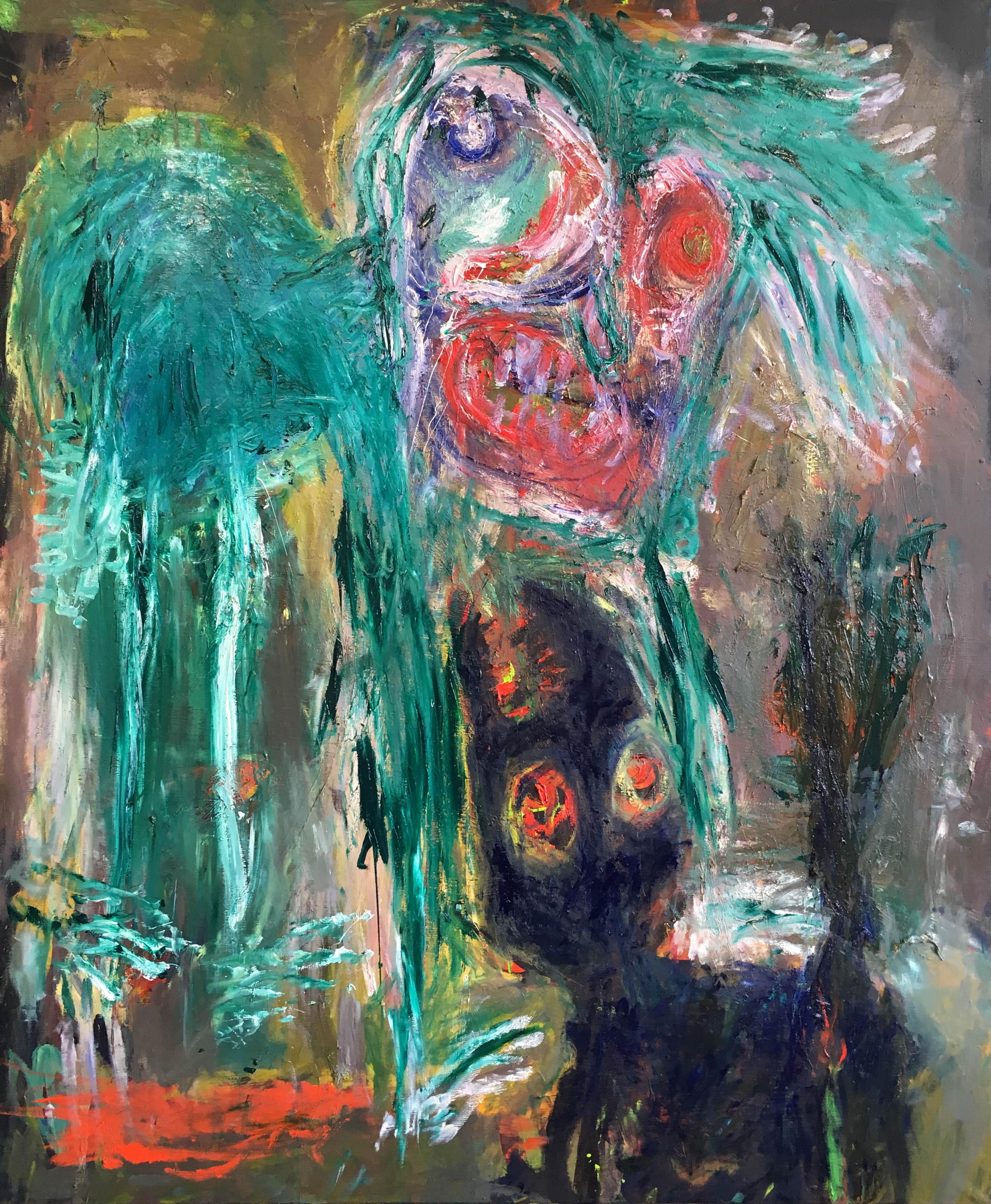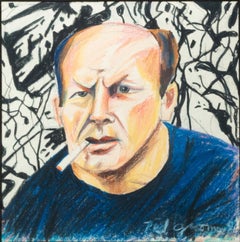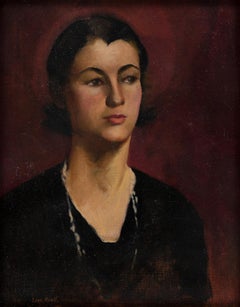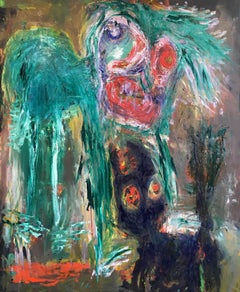
"Master Copy of Jan Van Eyck" Jack Levine, Expressionist Portrait, Figurative
View Similar Items
Want more images or videos?
Request additional images or videos from the seller
1 of 8
Jack Levine"Master Copy of Jan Van Eyck" Jack Levine, Expressionist Portrait, Figurative
About the Item
- Creator:Jack Levine (1915, American)
- Dimensions:Height: 20 in (50.8 cm)Width: 16 in (40.64 cm)
- Medium:
- Movement & Style:
- Period:
- Condition:
- Gallery Location:New York, NY
- Reference Number:1stDibs: LU1841213495702
About the Seller
5.0
Platinum Seller
These expertly vetted sellers are 1stDibs' most experienced sellers and are rated highest by our customers.
Established in 2021
1stDibs seller since 2022
60 sales on 1stDibs
Typical response time: 1 hour
More From This SellerView All
- "The Pensive Beauty, " Carl Nordell, American Impressionism, Female PortraitBy Carl NordellLocated in New York, NYCarl Nordell (1885 - 1957) The Pensive Beauty Oil on canvas 40 x 32 inches Signed lower left Nordell was born in Copenhagen on 23 September 1885. In 1892 the Nordell family settled in Westerly, New Jersey, where Carl Johan, one of several children, received his education. Reportedly, a local gambler and art collector, Richard Canfield was so impressed with young Nordell's talent that he assisted him to gain admittance to the Rhode Island School of Design. Carl was a tireless student and serious in his studies of art, literature, and philosophy. Friends nicknamed him "The American Frans Hals," as a result of his study of that Dutch master. After graduating from the school in 1905, Nordell continued his training at the Art Students League in New York City for the following two years. There he received criticism and instruction from George Bridgman (1864-1943), a noted teacher of anatomy, and Frank Vincent DuMond (1865-1951), a landscapist associated with Old Lyme. The popularity of Impressionism in America at this time had reached its peak, and the style was of paramount influence in Nordell's advanced studies. Around 1906, Nordell visited an exhibition of paintings by the Ten, most of whom were American Impressionists. Moved by the work of Tarbell and Joseph R. De Camp, he sought instruction from them at the School of the Museum of Fine Arts, Boston. Nordell worked diligently under Tarbell and experimented with the genre of women in interiors, or Intimism. In 1909, Nordell received the Paige Traveling Scholarship, which provided for two years of continued study in Europe. He became one of the hundreds of Americans to receive criticism from Jean-Paul Laurens at the Académie Julian in Paris. From this base, he made study trips to visit major museums and galleries in Italy, Holland, Spain and Germany and during this period Nordell's style reached a level of uniqueness, though he definitely remained under the general influence of French Impressionism. By the time of his return to Boston in 1911, Nordell had successfully incorporated the use of broken color, a high-keyed palette, and the practice of working en plein air to achieve an accurate representation of light and atmosphere. In October of that year, the Boston Art Club presented eighty-seven of Nordell's watercolors and oils to the viewing public. Some of the watercolors seem revolutionary in their spontaneity. Nordell continued his career in Boston at Fenway Studios and exhibited in national competitions, including the annuals of the National Academy of Design, the Art Institute of Chicago; at the 1912 biennial of the Corcoran Gallery he won the fourth Clarke Prize. Nordell's finances were augmented by portrait commissions of some of Boston's affluent citizens. The artist was so intent on recording the sitter's likeness that in this genre, he deviated from his usual impressionist technique. In the women-in-interior genre, he frequently depicted a fully draped woman seated in profile or at an oblique angle to the picture plane. These pensive and attractive young ladies usually gaze into space and become an integral part of the pleasant ambiance of the scene. In this way, Nordell remained within the Genteel Tradition as it was manifest in Boston. The artist exhibited several such works in the Panama-Pacific International Exposition in San Francisco in 1915, and won a silver medal for his efforts. In 1918, a one-man exhibition of fifty works was presented at the Boston Art Club. Nordell remained active in the Boston area art clubs and societies through the early 1920s. In the winter of 1921 Babcock Art Galleries presented him with yet another one-man show. During this period, Nordell increased the production of prints and won the Salmagundi Club's Shaw Prize for etching in 1923. Sometime after 1927 he began taking summer sketching trips to Chautauqua Lake...Category
Early 20th Century American Impressionist Figurative Paintings
MaterialsCanvas, Oil
- "Jackson Pollock, " Red Grooms, New York School Pop Art PortraitBy Red GroomsLocated in New York, NYRed Grooms (American, b. 1937) Jackson Pollock, 1986 Pastel on paperboard 9 1/4 x 9 1/4 inches Signed and dated lower right Provenance: Hirschl & Adler Modern, New York Charles Rog...Category
1980s Pop Art Portrait Paintings
MaterialsPastel, Board
$18,400 Sale Price20% Off - "Portrait of a Woman, " Leon Kroll, Mid-Century American RealismBy Leon KrollLocated in New York, NYLeon Kroll (1884 - 1974) Portrait of a Woman, circa 1950 Oil on canvas 20 3/4 x 17 inches Signed lower left Provenance: Private Collection, New York Private Collection, North Caroli...Category
1950s American Realist Portrait Paintings
MaterialsCanvas, Oil
$5,600 Sale Price20% Off - "Portrait of a Lady, " Vlaho Bukovac, Croatian ArtistLocated in New York, NYVlaho Bukovac (Croatian, 1855 - 1922) Portrait of a Lady Oil on canvas 18 1/2 x 15 inches Signed left middle Provenance: Private Collection Toronto Kuns...Category
Late 19th Century Portrait Paintings
MaterialsCanvas, Oil
$34,000 Sale Price20% Off - "Marion Jones Farquhar" Frederick William Macmonnies, Tennis Olympian PortraitBy Frederick William MacMonniesLocated in New York, NYFrederick William Macmonnies Marion Jones Farquhar, 1905-11 Oil on canvas 24 x 20 inches Provenance: William Clerk Private Collection, New York Literature: Mary Smart, A Flight with Fame: The Life and Art of Frederick MacMonnies, with a Catalogue Raisonne of Sculpture and a Checklist of Paintings by E. Adina Gordon, Madison, Connecticut, 1996, no. 90. The work depicts Marion Jones Farquhar who, was an American tennis player who competed during the late 19th century and early 20th century. She won the singles titles at the 1899 and 1902 U.S championships and was the first American woman to medal at the Olympics placing Bronze in singles. Additionally, she was the artist's sister-in-law who often played and competed with MacMonnies in golf and tennis. MacMonnies would often study the movements of her form referenced in his sculpture. When MacMonnies won a doubles golf tournament he said "Marion dragged my dead weight thro' and won us the tournament, showing what great Generalship can do." A sculptor of classical figures, American-born Frederick MacMonnies had fame in the United States and Europe in the later half of the 19th century and early 20th century. He occasionally returned to America but lived most of his life as in expatriate in France. He was especially known for his lithe bronze figures, especially ones titled Diana. The classical names of these figures allowed him the appearance of propriety but gave him the opportunity to model svelte nudes. Frederick MacMonnies was one of the first American sculptors to recognize the potential market of the middle class. He copyrighted his works and then contracted with foundries to mass produce some of his figures such as Diana in smaller sizes. MacMonnies was born in Brooklyn, New York, and was a child prodigy at carving stone. At age 18, he worked in the studio of Augustus Saint-Gaudens, and then persuaded him to become his assistant, keeping models damp and covered, running errands, and cleaning the studio. Evenings he studied at the Art Students League, Cooper Union, and the National Academy of Design. In Saint-Gaudens' studio, he met many of the wealthy people who shared Saint-Gaudens Beaux-Arts based ideas that art and architecture should be unified in order to create public art in America equal to that of classical antiquity or Renaissance Europe. Among the men that MacMonnies met through Saint-Gaudens who later furthered his career were architects Stanford White and Charles McKim...Category
Early 1900s American Impressionist Portrait Paintings
MaterialsCanvas, Oil
- "Child in an American Landscape" James Gantt, Midwestern Regionalism, MissouriLocated in New York, NYJames Britton Gantt (1911 - 1984) Child in an American Landscape, 1940 Egg tempera on board 17 1/2 x 14 inches Signed and dated lower right Provenance: Private Collection, San Francisco Regarding this painting, the artist's daughter said, "The subject matter of your painting reflects my father's propensity for presenting minority figures with dignity, as well as an admiration for the contributions of hard-working people. The painting's background packs in details reminiscent of the technique he used working on mural projects." Painter, printmaker, muralist. Born in Lawrence, Douglas County, Kansas (some sources wrongly indicate Kansas City), the son of Euphemia Lane Fox Blackburn (1883 – 1929) and Charles Whittle Gantt (1881 – 1952). He was the grandson and namesake of Judge James Britton Grant (1845 – 1912), a former Chief justice of the Supreme Court of Missouri. His father, Charles, though trained as a lawyer, suffered from alcoholism and instead worked for the railroad. James Gantt...Category
1940s American Realist Portrait Paintings
MaterialsBoard, Oil
$13,000 Sale Price35% Off
You May Also Like
- Coach André Bard - Julien Wolf, 21st Century, Contemporary figurative paintingBy Julien WolfLocated in Paris, FROil on canvas Signed Unique workCategory
2010s Expressionist Figurative Paintings
MaterialsCanvas, Oil
- Supper is not over ! - Julien Wolf, Contemporary Expressionist PaintingBy Julien WolfLocated in Paris, FROil on canvas 2019 Signed Unique work Julien Wolf is a French painter who was born in Strasbourg in 1981, France. In 2007, he graduated and obtained the DNSEP Art and Decorative Art section...Category
2010s Expressionist Figurative Paintings
MaterialsCanvas, Oil
- Isa, Génie, Catou, Patoche and Didine - Julien Wolf, 21st Century, PaintingBy Julien WolfLocated in Paris, FROil on canvas 2018 Signed on the back Unique workCategory
2010s Expressionist Figurative Paintings
MaterialsCanvas, Oil
- Geez ! - Julien Wolf, 21st Century, Contemporary Expressionist PaintingBy Julien WolfLocated in Paris, FROil on canvas 2019 Signed Unique work Julien Wolf is a French painter who was born in Strasbourg in 1981, France. He graduated in 2007 at the DNSEP Art and Decorative Art section...Category
2010s Expressionist Figurative Paintings
MaterialsCanvas, Oil
- He grabs it by the tail - Julien Wolf, Contemporary Expressionist PaintingBy Julien WolfLocated in Paris, FROil on canvas 2019 Signed Unique work Julien Wolf is a French painter who was born in Strasbourg in 1981, France. He graduated in 2007 at the DNSEP Art and Decorative Art section a...Category
2010s Expressionist Figurative Paintings
MaterialsCanvas, Oil
- Recovery - Julien Wolf, 21st Century, Contemporary Expressionist PaintingBy Julien WolfLocated in Paris, FROil on canvas 2019 Signed Unique work Julien Wolf is a French painter who was born in Strasbourg in 1981, France. He graduated in 2007 at the DNSEP Art and Decorative Art section...Category
2010s Expressionist Figurative Paintings
MaterialsCanvas, Oil



